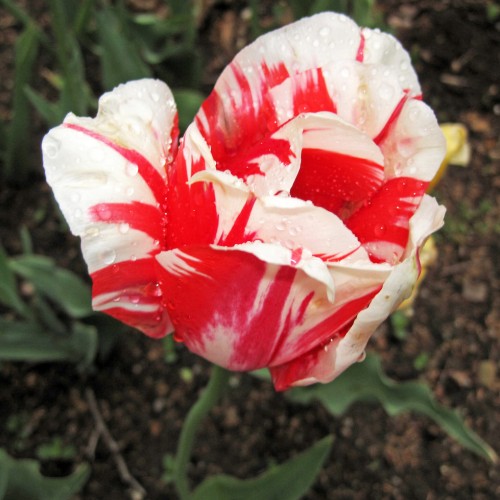
tulip
Tulipa (group)
Cycle:
Perennial
Watering:
Average
Hardiness Zone:
3 - 8
Flowers:
Flowers
Sun:
full sun
Leaf:
Yes
Growth Rate:
High
Maintenance:
Low
Drought Tolerant:
Yes
Salt Tolerant:
Yes
Indoors:
Yes
Care Level:
High
watering
Tulips need regular watering, about 1-2 inches of water per week. When watering, it is best to water deeply and less frequently to promote deeper root growth. During the active growing season, tulips should be watered once a week. During the dormancy period, tulips should be watered every other week. Tulips should never be allowed to dry out completely. If the soil goes too long without water, the plant may not recover.
sunlight
Tulips require approximately 6 to 8 hours of direct sunlight per day, ideally in the early morning or late afternoon. The best time of day for a tulip to receive the most sunlight is between 9 am and 5 pm. However, it is important not to give the plant more than 8 hours of direct sunlight a day as too much direct sunlight can be damaging to the plants. In addition, during peak summertime temperatures, it is important to provide shade for the tulips to prevent sunburn or wilting.
pruning
The best time to prune tulips is just after they finish blooming in the late spring or early summer. Cut off all the dead flower heads and surrounding foliage. This will help the growing bulbs to put more energy into producing flowers next year. For most varieties, prune the foliage to the ground. However, for some varieties, pruning should be done much more delicately. For these varieties, you should prune the foliage only to about 25 to 35 inches tall, allowing the leaves to remain healthy and strong. Pruning will make the plant look much healthier and more vibrant.
Season
Hardiness Map
FAQ
Is the tulip a popular spring-blooming flower?
Yes, the tulip is a popular spring-blooming flower. Each spring, millions of tulips bloom brightly in an array of colors, making them a favorite flower of people around the world. People frequently cut tulips and bring them into their homes to enjoy their beauty and scent. Tulips are also frequently seen at weddings and other special events in the spring. Their colorful and eye-catching petals bring added beauty and cheerfulness to the occasion.
Are tulips grown in different colors?
Yes, tulips are grown in many different colors. They are available in virtually every color in the spectrum, offering something for everyone. Popular colors include white, pink, yellow, orange, red, and purple. Some tulips, such as parrot tulips, even come in unique color combinations and designs. Furthermore, some tulips are even available in black and blue, though these are less common.
Can tulips be grown indoors as houseplants?
Yes, tulips can be grown indoors as houseplants! While tulips thrive best in a cool environment with plenty of light, it's possible to grow them indoors. Choose a variety that is suitable for indoor growth, such as tulips with smaller major bulbs, and make sure you provide them with plenty of light and water so that they get enough energy and stay healthy. You should also give them a cool winter rest period of 4-6 weeks to encourage better flowering when used as houseplants.
Could tulips symbolize love and passion?
Yes, tulips can absolutely symbolize love and passion. This is because the tulip is a flower that is often associated with beauty, elegance and grace, and its shape often resembles that of a rose or heart shape. This symbolism of the tulip as a beautiful and elegant flower is usually seen in its representation of love and passion. Additionally, the color of tulips can also represent different emotions, such as red representing intense emotions and pink representing love and romance.
Should tulips be planted in a specific season?
Yes, tulips should be planted at a specific season. Generally, tulips should be planted in the autumn for the best results. If planted too early or too late, the plants may suffer and not bloom. While tulips can be planted any time between late summer and early winter in some climates, most gardeners recommend planting in late September or October for the best results.
Do tulips require specific soil conditions?
Yes, tulips require specific soil conditions in order to grow best. They prefer sandy, well-draining soils that are slightly acidic, with a pH of 6.5 to 7.0. In areas with more alkaline soil, it's best to amend it with sulfur prior to planting. Tulips may also be planted in containers as long as the soil is kept moist but not soggy, as too much moisture can cause the bulbs to rot. Fertilize in the spring when days are longer and temperatures are warmer for best results.
Do tulips need full sun to grow?
Tulips do need full sun to grow. They need at least six hours of sun daily to thrive and bloom. When planted in the correct environment, the bulbs can reach full maturity and will produce the best quality blooms. The more sun they can access, the better the bloom. Although tulips can grow in partial shade, they need plenty of direct sunlight to provide the best growth and blooms.
Are tulips easy to grow and maintain?
Tulips are generally quite easy to grow and maintain. They prefer full sun and well-drained soil, and typically require only occasional watering, especially during extended dry periods. Once the bulbs are planted, they can largely be left alone and will usually bloom in the spring, their blooms lasting 1-2 weeks. Deadheading spent blooms can help prolong flowering, as can ensuring that plants have enough moisture during blooming season. Regular fertilization will help ensure strong growth and flowering in subsequent years, as when tulips are left alone, they tend to decline in productivity over time.
